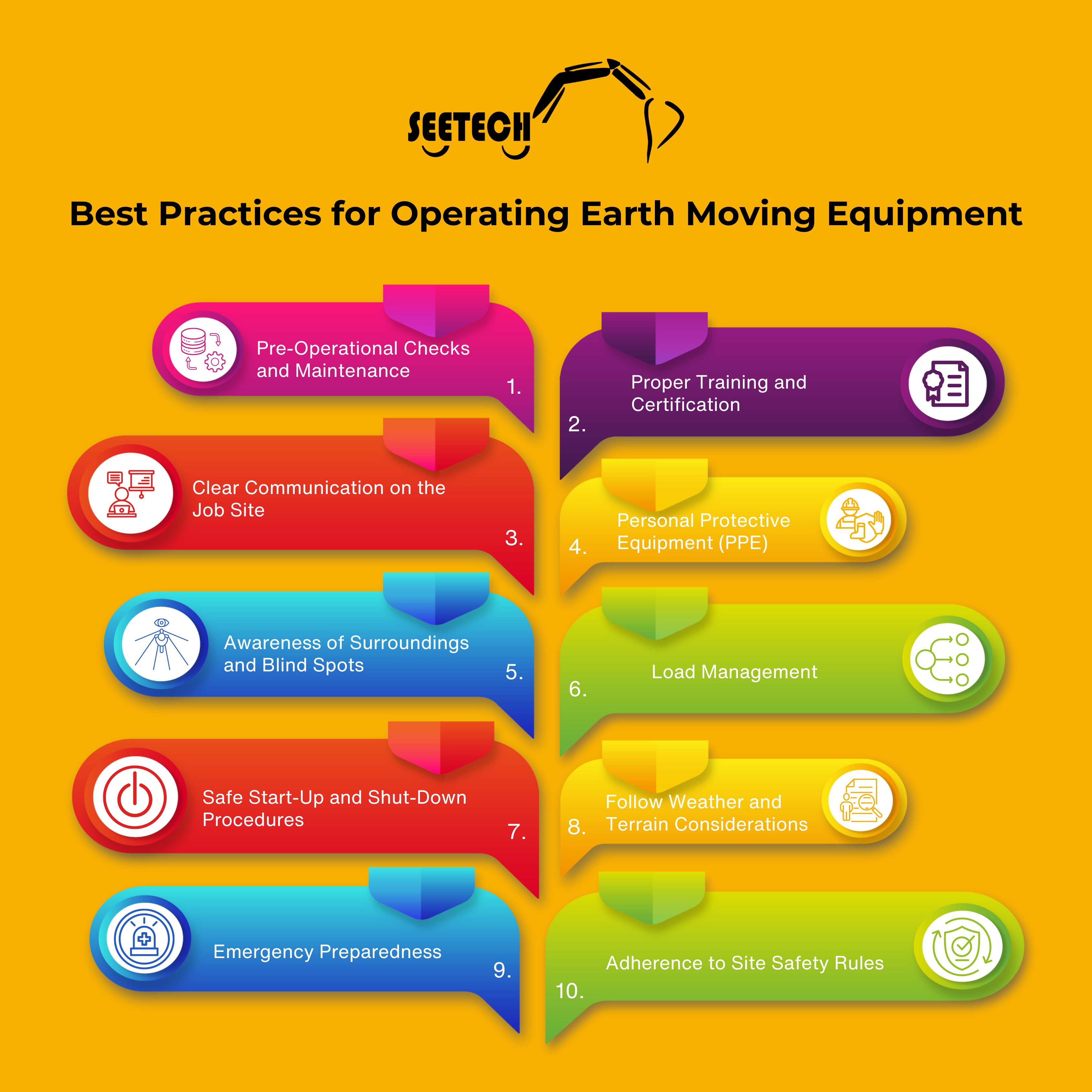Sign In
seetech's blog

Operating earth moving equipment, such as bulldozers, excavators, and loaders, is essential in the construction, mining, and industrial sectors. While these machines are designed for heavy-duty tasks, ensuring the safety of operators, site workers, and bystanders is crucial to prevent accidents. Adhering to safety best practices can minimize risks and create a safer work environment. Below are key safety protocols to follow when operating earth moving equipment.
1. Pre-Operational Checks and MaintenanceBefore using any earth moving equipment, it's essential to conduct a thorough inspection to ensure that everything is in working order. Regular maintenance helps in identifying potential mechanical failures before they become major problems. Key areas to inspect include: • Brakes, lights, and horns • Fluid levels (oil, coolant, hydraulic fluid) • Tires or tracks for wear and tear • Hydraulic lines and connections for leaks • Warning devices and fire extinguishers By maintaining the equipment, you reduce the risk of unexpected breakdowns and improve overall site safety.2. Proper Training and CertificationOperating heavy machinery requires specialized knowledge and skills. All operators should be certified and undergo training to understand how to handle the equipment safely. This includes: • Understanding machine controls and safety features • Familiarity with the specific type of equipment • Ability to assess load limits and balance Trained operators can handle earth moving equipment more effectively, minimizing the risk of accidents.3. Clear Communication on the Job SiteGood communication is vital for maintaining safety when operating earth moving machinery. Workers and operators should use hand signals, radios, or other communication devices to stay in constant contact. A designated signal person can help guide operators, especially in areas with poor visibility. Key communication practices include: • Signaling clear paths for operation • Informing workers of equipment movements in real-time • Using standard hand signals that all personnel understand Clear communication prevents confusion, reducing the likelihood of accidents.4. Personal Protective Equipment (PPE)Wearing the right personal protective equipment (PPE) is critical for everyone on the job site. For operators, PPE may include: • Hard hats to protect against falling objects • High-visibility vests for visibility around heavy machinery • Steel-toe boots to prevent foot injuries • Gloves to protect hands when operating or maintaining equipment Ensuring that everyone is properly equipped enhances overall safety.5. Awareness of Surroundings and Blind SpotsEarth moving equipment often has large blind spots, making it difficult for operators to see other workers or obstacles around them. To avoid accidents, operators must: • Use mirrors, cameras, and sensors to improve visibility • Keep a close eye on ground personnel • Never operate equipment unless the surrounding area is clear • Ensure bystanders maintain a safe distance All workers should be educated on the danger zones and stay clear of operating equipment to avoid accidents.6. Load ManagementManaging loads correctly is a crucial part of safe earth moving equipment operation. Overloading equipment or improperly distributing weight can lead to tipping or other dangerous situations. Operators should: • Ensure the equipment's load capacity is not exceeded • Properly secure materials before moving • Keep loads balanced to prevent tipping • Use appropriate lifting techniques to avoid stress on the machinery Effective load management is key to preventing equipment damage and accidents.7. Safe Start-Up and Shut-Down ProceduresStarting and shutting down equipment correctly is another important safety measure. Operators should: • Perform pre-start checks • Ensure no one is near the equipment before starting it • Follow the manufacturer’s procedures for starting and stopping the machine • Engage the parking brake before exiting By following proper start-up and shut-down protocols, operators can avoid unintended movements and hazards.8. Follow Weather and Terrain ConsiderationsExtreme weather conditions and uneven terrain can make operating earth moving equipment more dangerous. Safety practices include: • Adjusting operation speed in wet, slippery, or icy conditions • Avoiding steep slopes or unstable ground • Using appropriate attachments for different soil types and weather conditions • Securing machinery during strong winds or storms Understanding and respecting environmental conditions helps ensure safe equipment use.9. Emergency PreparednessHaving a clear emergency response plan is critical for dealing with accidents or malfunctions. Operators and workers should: • Know where emergency stop buttons and controls are located • Be trained in first aid and CPR • Have access to first aid kits and fire extinguishers • Report accidents or safety concerns immediately Being prepared for emergencies minimizes the impact of unexpected incidents.10. Adherence to Site Safety RulesEvery construction or industrial site will have specific safety rules that operators must follow. These rules are designed to protect everyone working in and around earth moving equipment. Site safety protocols may include: • Speed limits for equipment • Designated paths for machinery movement • Safe zones for workers and equipment parking Operators should adhere to site safety rules to ensure the well-being of everyone on the job.ConclusionSafety is a top priority when operating earth moving equipment. By following these best practices—conducting regular maintenance, providing operator training, maintaining clear communication, and adhering to site-specific rules—you can reduce the risk of accidents and create a safer, more efficient work environment. Remember, safety not only protects individuals but also increases productivity and ensures smoother project completion.